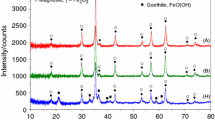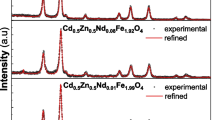Abstract
The effect of a uniform magnetic field with flux density up to 1 T on the electrodeposition of Fe from sulphate electrolyte has been investigated under different field configurations relative to the electrode surface. Voltammetric and chronoamperometric experiments have been carried out coupled with an electrochemical quartz crystal microbalance for in situ mass change measurements. The structure and morphology of the deposited films were determined by scanning electron microscopy, atomic force microscopy and X-ray diffraction measurements. Results show that, when the magnetic field is applied parallel to the electrode surface, the limiting current density and the deposition rate are increased due to the magnetohydrodynamic effect. The nucleation process is also affected in parallel configuration; the current density of the maximum on the chronoamperograms is decreased, and an additional nucleation step might be observed. This effect is attributed to the hydrodynamic response of the electrochemical system. No significant influence on the electrochemical reaction was observed when a magnetic field was applied perpendicular to the electrode. But in this configuration, the morphology of deposited layers is changed by the magnetic field. The morphology changes are discussed. No effect of the magnetic field on the crystallographic structure was observed.















Similar content being viewed by others
References
Tacken RA, Janssen LJJ (1995) J Appl Electrochem 25:1
Hinds G et al (2001) J Phys Chem B 105:9487
Shannon JC, Gu ZH, Fahidy TZ (1997) J Electrochem Soc 144:L314
Lioubashevski O, Katz E, Willner I (2004) J Phys Chem B 108:5778
Aaboubi O et al (1990) J Electrochem Soc 137:1796
Devos O et al (1998) J Electrochem Soc 145:401
O’Reilly C, Hinds G, Coey JMD (2001) J Electrochem Soc 148:C674
Tabakovic I et al (2003) J Electrochem Soc 150:C635
Nikolic ND et al (2004) J Magn and Magn Mater 272–276:2436
Uhlemann M, Schlörb H, Msellak K, Chopart JP (2004) J Electrochem Soc 151:C598
Rabah KL et al (2004) J Electroanal Chem 571:85
Leventis N, Dass A (2005) J Am Chem Soc 127:4988
Uhlemann M, Krause A, Chopart JP, Gebert A (2005) J Electrochem Soc 152:C817
Matsushima H et al (2006) J Electroanal Chem 587:93
Fahidy TZ (1999) The effect of magnetic fields on electrochemical processes. In: Conway BE et al (ed) Modern aspects of electrochemistry, vol 32. Kluwer/Plenum, New York, pp 333–354
Coey JMD, Hinds G (2001) J Alloys Compd 326:238
Devos O et al (2000) J Phys Chem A 104:1544
Aogaki R, Fueki K, Mukaibo T (1975) Denki Kagaku oyobi Kogyo Butsuri Kagaku 43:504
Leventis N, Gao X (1999) J Phys Chem B 103:5832
Ragsdale SR, White HS (1999) Anal Chem 71:1923
Ragsdale SR, Grant KM, White HS (1998) J Am Chem Soc 120:13461
O’Brien RN, Santhanam KSV (1997) J Appl Electrochem 27:573
Waskaas M, Kharkats YI (1999) J Phys Chem B 103:4876
Coey JMD, Rhen FMF, Dunne P, McMurry S (2007) The magnetic concentration gradient force—is it real? J Solid State Electrochem. DOI 10.1007/s10008-006-0254-4
Uhlemann M, Gebert A, Schultz L (2004) Electrochim Acta 49:4127
Osaka T et al (2003) Electrochem Solid-State Lett 6:C35
Vetter KJ (1961) Elektochemische kinetik. Springer, Berlin Heidelberg New York
Wang J (2000) Analytical electrochemistry, 2nd edn. Wiley VCH, New York
Krause A (2005) Electrokristallisation von Kobalt und Kupfer unter Einwirkung homogener Magnetfelder. PhD thesis, TU Dresden
Armstrong RD, Harrison JA (1969) J Electrochem Soc 116:328
Scharifker B, Hills G (1983) Electrochim Acta 28:879
Palomar-Pardave M, Gonzalez I, Batina N (2000) J Phys Chem B 104:3545
Thirsk HR, Harrison JA (1972) A guide to the study of electrode kinetic. Academic, London and New York
Sahari A et al (2006) Catal Today 113:257
Bento FR, Mascaro LH (2006) Surf Coat Technol 201:1752
Daltin AL, Chopart JP (2005) The effect of magnetic fields on cuprous oxide electrodeposition. In: Proceedings of 6th International PAMIR Conference on fundamental and applied MHD, vol 2, Rigas Jurmala Latvia, pp 179–182
Palomar-Padave M, Scharifker BR, Arce EM, Romero-Romo M (2005) Electrochim Acta 50:4736
Acknowledgements
The German Research Foundation (DFG) is gratefully acknowledged for the support of this work in the framework of SFB609 “Elektromagnetische Strömungsbeeinflussung in Metallurgie, Kristallzüchtung und Elektrochemie.”
Author information
Authors and Affiliations
Corresponding author
Rights and permissions
About this article
Cite this article
Koza, J., Uhlemann, M., Gebert, A. et al. The effect of magnetic fields on the electrodeposition of iron. J Solid State Electrochem 12, 181–192 (2008). https://doi.org/10.1007/s10008-007-0379-0
Received:
Revised:
Accepted:
Published:
Issue Date:
DOI: https://doi.org/10.1007/s10008-007-0379-0




